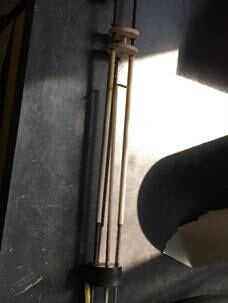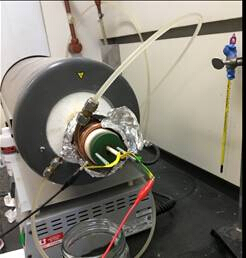Espectroscopia de impedancia electroquímica
Visión general
Fuente: Kara Ingraham, Jared McCutchen y Taylor D. Sparks,Department of Materials Science and Engineering, The University of Utah, Salt Lake City, UT
La resistencia eléctrica es la capacidad de un elemento de circuito eléctrico para resistir el flujo de electricidad. La resistencia se define por la Ley de Ohm:
 (Ecuación 1)
(Ecuación 1)
Dónde  está
está  la tensión y está la corriente. La ley de Ohm es útil para determinar la resistencia de las resistencias ideales. Sin embargo, muchos elementos de circuito son más complejos y no se pueden describir solo por resistencia. Por ejemplo, si se utiliza una corriente alterna (CA), la resistividad a menudo dependerá de la frecuencia de la señal de CA. En lugar de utilizar la resistencia por sí solo, la impedancia eléctrica es una medida más precisa y generalizable de la capacidad de un elemento de circuito para resistir el flujo de electricidad.
la tensión y está la corriente. La ley de Ohm es útil para determinar la resistencia de las resistencias ideales. Sin embargo, muchos elementos de circuito son más complejos y no se pueden describir solo por resistencia. Por ejemplo, si se utiliza una corriente alterna (CA), la resistividad a menudo dependerá de la frecuencia de la señal de CA. En lugar de utilizar la resistencia por sí solo, la impedancia eléctrica es una medida más precisa y generalizable de la capacidad de un elemento de circuito para resistir el flujo de electricidad.
Más comúnmente, el objetivo de las mediciones de impedancia eléctrica es la desconvolución de la impedancia eléctrica total de una muestra en contribuciones de diferentes mecanismos como resistencia, capacitancia o inducción.
Procedimiento
- Obtenga un módulo de prueba y conéctalo a los instrumentos EIS a través de dos electrodos. El módulo de prueba, que se muestra en la Figura 3, proporciona datos que se pueden utilizar para modelar un circuito simple y conocido. Se puede utilizar para confirmar que los cables están conectados a la máquina correctamente y que todas las piezas de maquinaria están funcionando.

Figura 3
Resultados
Los resultados de EIS se presentan a menudo en una gráfica Nyquist, que muestra impedancia real frente a impedancia compleja en cada frecuencia probada. La gráfica del experimento se ha ejecutado se puede ver en la Figura 6.

Figura 6: Captura de pantalla de la computadora después de l...
Aplicación y resumen
La espectroscopia de impedancia electroquímica es una herramienta útil para determinar cómo un nuevo material o dispositivo impide el flujo de electricidad. Para ello, aplica una señal de CA a través de los electrodos conectados a la muestra. Los datos son recogidos y trazados por el ordenador en la llanura compleja. Con la ayuda del software, el gráfico se puede modelar a partir de partes específicas de un circuito. Estos datos a menudo pueden ser muy complicados y requieren un análisis cuidadoso. Esta técnica,...
Tags
Saltar a...
Vídeos de esta colección:

Now Playing
Espectroscopia de impedancia electroquímica
Materials Engineering
23.4K Vistas

Materialografía óptica Parte 1: Preparación de las muestras
Materials Engineering
15.6K Vistas

Materialografía óptica Parte 2: Análisis de imágenes
Materials Engineering
11.1K Vistas

Espectroscopía de fotoelectrones de rayos X
Materials Engineering
21.9K Vistas

Difracción de rayos X
Materials Engineering
89.6K Vistas

Haz de iones focalizado
Materials Engineering
9.0K Vistas

Solidificación direccional y estabilización de fase
Materials Engineering
6.7K Vistas

Calorimetría diferencial de barrido
Materials Engineering
38.6K Vistas

Difusividad térmica y el método del pulso láser
Materials Engineering
13.4K Vistas

Galvanoplastia de películas finas
Materials Engineering
20.2K Vistas

Análisis de la expansión térmica mediante dilatometría
Materials Engineering
16.0K Vistas

Materiales compuestos de matriz cerámica y sus propiedades de flexión
Materials Engineering
8.4K Vistas

Aleaciones nanocristalinas y estabilidad del tamaño de los nanogranos
Materials Engineering
5.2K Vistas

Síntesis de hidrogeles
Materials Engineering
23.8K Vistas
ACERCA DE JoVE
Copyright © 2025 MyJoVE Corporation. Todos los derechos reservados

